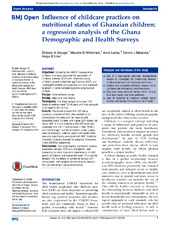| dc.description.abstract | Objectives: Guided by the UNICEF framework for childcare, this study examined the association of childcare practices (CCP) with infant and young children’s growth (height-for-age Z-scores, HAZ), and investigated whether care practices are more important to growth in some sociodemographic subgroups of children. Design: Cross-sectional survey. Setting: Urban and rural Ghana. Participants: The study sample comprised 1187 dyads of mothers aged 15–49 years and their youngest child (aged 6–36 months). Results: The results showed that CCP was a significant predictor of HAZ, after controlling for covariates/confounders at child, maternal and household levels. Children with higher CCP scores had higher HAZ. A 1-unit increase in the CCP score was associated with a 0.17-unit increase in HAZ. Child’s and mother’s age, number of children under 5 years, place of residence, maternal weight and wealth index were also significantly associated with HAZ. Statistical interaction analyses revealed no subgroup differences in the CCP/HAZ relationship. Conclusions: This study found a significant, positive association between CCP and child growth, after accounting for other important determinants of child growth at maternal and household levels. This calls for research into the effects on growth of various CCP components, with longitudinal cohort study designs that can disentangle causal relationships. | en_US |

